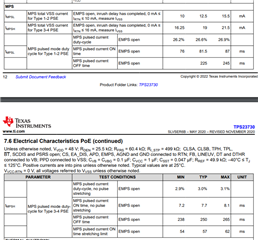Hi,
We have designed Isolated Class 6 POE++ power supply as per reference schematics PMP22494_RevA_SH2.SchDoc using TPS23730 IC.
In no load condition we have maintain output load by adding bleeder resistor on 12V, such that input current on POE RJ45 input is >18mA with input voltage from 44V to 52V
During circuit operation the input wattage on RJ45 PD input is dynamic and ranges from 6W to 25W in one case and 6W to 45W in another case.
We had put Classification resistors CLSA = 31.7 ohms (27 ohms + 4.7ohms) & CLSB = 130 ohms (120ohms + 10 Ohms).
DEN pin is connected with 25.5K resistor to VDD as in the reference schematics.
The PSE output would be from Type 2 802.3at or Type 3 802.3bt Ethernet swtich.
What should be the condition of EMPS pin, should we enable or keep disable by connecting to PGND?
What is the significance of EMPS pin?
The circuit would operate as usual with PSE input by performing class identification.
Regards,
KIRAN SURVE



